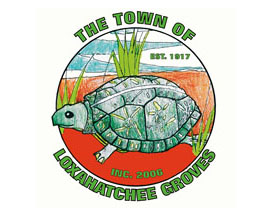The Loxahatchee Groves Unified Land Development Committee recommended final changes to the town’s commercial sign codes on Tuesday, Oct. 29, focusing on the design of monument signs.
Committee Chair Marianne Miles suggested discussing commercial signs focusing on what they as a committee want to change or not, rather than go line by line.
“I feel our codes need to be simplified so lay people can understand,” Miles said, adding that she wants the code to be flexible so that it is open to new concepts, rather than hold developers to specific rules. “If we want to determine that each shopping center is to be different than the next shopping center, then we discuss it, rather than take what seems like forever to get through it.”
Planning consultant Jim Fleischmann said at their previous meeting, the committee had discussed the design of monument signs.
“I think the simplest way to deal with that is to have a consensus on the part of this committee as to whether or not we want to have some standard design criteria, such that all of the monument signs on Southern Blvd. look essentially the same, so that those signs reflect the fact that you’re in Loxahatchee Groves,” he said. “Or whether we give each individual freestanding building the opportunity to design their own sign.”
Fleischmann said that he personally preferred the first alternative, where the town has its own design standards. He said the balance of lots to be commercially developed on Southern Blvd. are relatively small in size, which could lead to many randomly designed signs.
“We can’t prohibit any of those property owners from having a sign,” he said. “It’s my feeling that we should have some basic sign criteria that establishes a consistent character of signs,” Fleischmann said. “There has always been discussion of, ‘We don’t want to be Military Trail.’ If we allow total judgement of the type of signs and the design of those signs on all of those properties, some people may say we’re getting pretty Military Trail-ish.”
Fleischmann explained that he felt the committee should probably set some basic sign rules without saying what language should be put on the signs. He said that the sign parameters for monument signs that the committee had discussed and recommended for adoption at a previous meeting assumed a certain design standard, with two 24-inch pillars on the outside of the sign face.
“The requirement for 24-inch borders, plus height and width, would be the basic sign criteria for all signs up and down Southern Blvd.,” he said. “What the pillars have to be made of, the architectural flavor of those signs, we could either dictate that or not.”
He said the current sign code does not dictate architecture or materials to use, clarifying that the current code only stipulates the pillars to be used and the height and width of the sign. He added that the Rural Vista guidelines outlined in the Loxahatchee Groves Neighborhood Plan were not mandated in the code but have been suggested by staff to developers.
Miles said the purpose of signs is to let people driving by know what services are available and felt the committee should make recommendations that fill that need.
“Publix is a bigger store, but on your sign face, two other smaller stores could be a little bit bigger on the bottom,” she said. “If the name of the game is to draw in business and let them stay and be viable, somebody going down the road has to know that the business is there and in existence.”
Fleischmann said he had talked to the owner of the Publix plaza many times, and he had never asked for a variance to the sign code. “They have never had any complaints from any of the tenants that they were losing business because passing traffic can’t tell who’s on the sign,” he said.
Board Member Cassie Suchy said she preferred staff’s recommendation of a uniform monument sign.
“I like the 24-inch [pillars],” Suchy said. “I don’t like extra wording. I don’t like giving developers the option. I do think we need to come up with some type of design and put it to the council.”
Board Member Lisa Trzepacz said she liked the design of the Publix monument sign. “I happen to think it is pretty good,” she said.
The allowable sign face is 60 square feet, but Fleischmann said the dimensions, including pillar size, are maximum and the tenant can always make the size smaller, pointing out that the 7-Eleven store in the plaza had made its monument sign smaller than it had to.
Fleischmann said the purpose of rewriting the code is to make it simpler.
“Staff has had a difficult time with all of the different signs that come in calculating the sign face,” he said. “We’re trying to make it simple by saying square footage of the entire area, including the frame.”
Suchy made a motion to follow staff’s recommendations for changes, which carried 3-1 with Trzepacz opposed.
The committee also discussed building wall signs, canopy signs, menu boards, window signs and directional or traffic control signs, approving staff’s recommendations for minor changes and clarifying the language. It also included the stipulation that in no case should the length of the sign exceed 75 percent of the building length or width of tenant footage.








